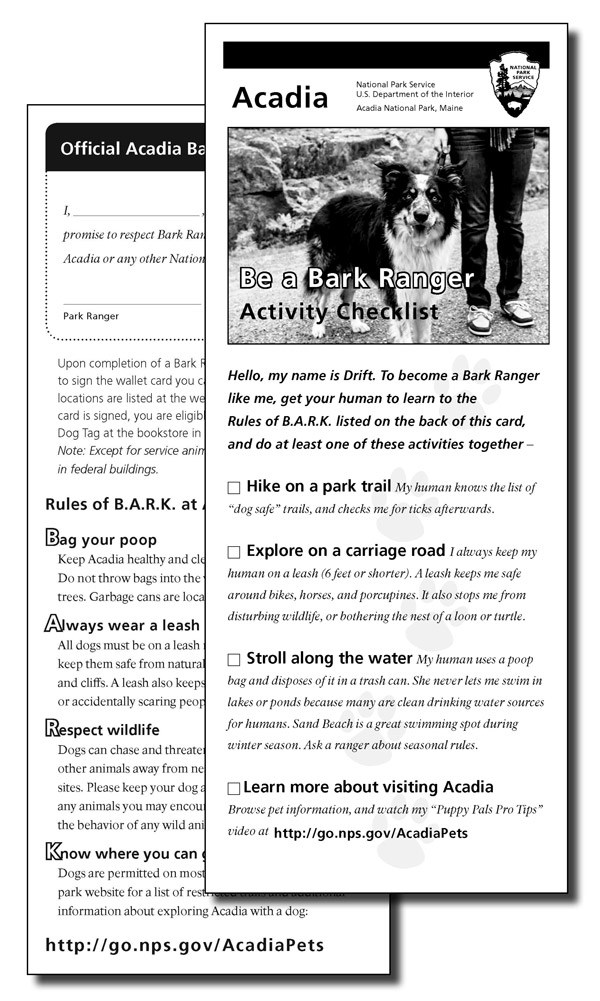Last updated: November 13, 2024
Article
Be an Acadia Bark Ranger

Activity Checklist
Do you like exploring Acadia with your canine friend? If so, stop by your campground ranger station, the Sieur de Monts Nature Center, or the Hulls Cove Visitor Center to pick up a copy of an activity checklist and learn more about Acadia’s Bark Ranger program.
The Bark Ranger program teaches dog owners about the importance of following the Rules of B.A.R.K. while visiting Acadia. Dogs completing this short program can be sworn in as Bark Rangers and their owners will be eligible to purchase a special Bark Ranger collar tag at the Eastern National Bookstore at the Hulls Cove Visitor Center.
Rules of B.A.R.K.
B = Bag Your Poop
-
Help keep Acadia clean by collecting and disposing of all dog waste. Be sure to carry the poop bag off the trail. Do not throw them into the woods or hang from trees. Public garbage cans are located throughout the park.
-
Dog feces is not a natural fertilizer. Dogs can carry disease such as parvovirus, giardia and roundworms into the park's wildlife populations. Water sources may also be polluted by dog feces.
A = Always Wear a Leash
-
Pets must be restrained on a leash no longer than 6 feet (2 m); retractable leashes extended beyond this limit are prohibited.
-
Leashes protect dogs from becoming lost and from wilderness hazards such as porcupines.
-
Not everyone is a dog person no matter how friendly and well behaved your dog may be. Dog friendly areas are a privilege would could be lost if leash regulations are not followed.
-
Many people, especially children, are frightened by dogs, even small ones. Uncontrolled dogs can present a danger to other visitors. Leashes also protect the experience of other visitors who may be afraid, allergic, or who do not want a dog approaching them.
-
Unfamiliar sights, sounds, and smells can disturb even the calmest, friendliest, and best-trained dog, causing them to behave unpredictably or bark excessively.
R = Respect Wildlife
-
Dogs can chase and threaten wildlife, scaring birds and other animals away from nesting, feeding, and resting sites.
-
Be especially careful around the nests of loons and turtles.
-
The scent left behind by a dog can signal the presence of a predator, disrupting or altering the behavior of park wildlife. Small animals may hide in their burrow the entire day after smelling a dog and may not venture out to feed.
-
Please keep your dog at a respectful distance from any animals you may encounter.
K = Know Where To Go
-
Pets should not be left unattended. Summer sunshine poses a threat to pets in vehicles. Don't leave pets alone in a car while hiking. Choose another hike or come back another day.
-
There are 100 miles (161 km) of hiking trails and 45 miles (72 km) of carriage roads in the park where pets are permitted. Blackwoods, Seawall, and Schoodic Woods campgrounds permit pets. On Isle au Haut, pets are permitted for day hiking only.
-
The following areas are closed or restricted to pets with the exception of service animals:
-
All public buildings, including Hulls Cove Visitor Center.
-
Ranger-led programs
-
Beaches at Echo Lake and Sand Beach, May 15–October 15.
-
Wild Gardens of Acadia at Sieur de Monts
-
Duck Harbor Campground on Isle au Haut
-
All areas that are closed to park visitors, such as remote island closures, to protect wildlife nesting. Most lakes in the park are public water supplies. Pets and people may not swim in them.
-
The six cliff ladder trails—Beehive, Beech Cliffs, Ladder, Perpendicular, Precipice, and Jordan Cliffs between Penobscot East and the carriage road.
-
Trails that are not appropriate for pet use:
-
Many park trails are not appropriate for pets due to the steep nature and the need to carry pets over terrain too difficult to negotiate without assistance. These trails include, but are not limited to—Acadia Mountain, Flying Mountain, Giant Slide, West Face of Cadillac Mountain, Pond Trail’s east end, Norembega Goat, Bubbles-Pemetic, Penobscot Mountain (Spring), Upper Beachcroft, and Upper Gorge.
-
Other Important Points:
-
Ticks are prevalent in Acadia, mostly active late spring to early fall. Check yourself and your dog thoroughly after a visit to the park to prevent any ticks from latching on to you or your dog. To limit your exposure to ticks:
-
Walk in the middle of trails away from tall vegetation
-
Wear light-colored clothing so ticks are easier to spot
-
Wear pants tucked into socks
-
Spray your shoes and clothing with repellent. Tick repellents, vests and bandanas are also available for your dog.
-
Remember, you are taking your pet into a different environment and you are responsible for your pet. Do you have enough water for yourself and your pet? Does your pet have the endurance (and paw pads) to hike the trail you have chosen? Have you considered your pet in all of your preparations? Nearly every summer weekend park rangers and rescue personnel face numerous carry-outs when hikers are injured or become ill. It's the job of all staff to keep visitors and the park safe. If your pet becomes disabled on the trail, what will you do? With a little preparation, you and your pet can have an enjoyable trip in Acadia National Park.
- Duration:
- 1 minute, 15 seconds
Acadia National Park is one of the few national parks across America that allows dogs. Learn why it's so very important for your furry friend to stay on leash, whether this is your first visit, or you come here together every day for years and years.
